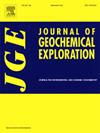Mineralogy, geochemistry, and S isotope investigation of seafloor massive sulfides from the Yunzang hydrothermal field, South Atlantic Ridge
IF 3.4
2区 地球科学
Q1 GEOCHEMISTRY & GEOPHYSICS
引用次数: 0
Abstract
Research on the ore-forming model of modern seafloor hydrothermal sulfide deposits is of significant economic and scientific importance. The limited research on recently discovered seafloor sulfide deposits has resulted in a vague comprehension of water-rock interactions, metal origins, and the subsequent metal deposition process. The Yunzang hydrothermal field is located on the South Mid-Atlantic Ridge and represents a newly discovered seafloor hydrothermal sulfide deposit. However, the geological features, primary mineral assemblages of ores, and the source regions of metals in the hydrothermal field remain unclear. In this study, sulfides were analyzed using a TESCAN Integrated Mineral Analyser (TIMA) and in-situ laser ablation inductively coupled plasma mass spectrometry (LA-ICP-MS) to investigate trace element distributions and S isotope compositions. Analysis by TIMA shows that the Yunzang hydrothermal field is mainly composed of pyrite, chalcopyrite, and sphalerite. Two types of ore with distinct characteristics were identified, one rich in chalcopyrite and the other in sphalerite. Within these ores, two different types of pyrite were identified, namely colloform and euhedral pyrite. Colloform pyrite formed at low temperature in outer margins of the chimney is enriched in Mn, V, Ag, Tl and Cd. Euhedral pyrite formed at high temperature in inner zone of the chimney is enriched in Co, Se, Cu and Sn. The variation in trace elements within pyrite is primarily governed by the synergistic effects of fluid conditions (such as temperature and redox state) and the influx of ambient seawater that accompanies the chimney formation process. The higher concentrations of Mo and V in the pyrite found in the outer wall of the chimney indicate significant interactions between seawater and hydrothermal fluids. The lower Au/As ratio in pyrite proves that gold exists within the lattice of pyrite rather than in nano-particles. The lower concentrations of Sn and Bi in chalcopyrite suggest that ore-forming materials may primarily originate from leaching of the surrounding rocks, with a lack of magmatic volatile components. The Fe/Zn ratio in sphalerite indicates that the Yunzang hydrothermal field belongs to sediment-starved SMS, with the formation temperature of sphalerite ranging from 242 to 262 °C. The positive δ34SV-CDT values of pyrite (1.0 ‰–3.7 ‰) suggest 83 %–96 % of S was derived from the leaching of basement basalts, 4 %–17 % from oxidation of seawater sulfate. Based on these analytical results, the growth history of chimney and the fluid source in the Yunzang hydrothermal field are proposed.
南大西洋脊云藏热液区海底块状硫化物的矿物学、地球化学及S同位素研究
对现代海底热液硫化物矿床成矿模式的研究具有重要的经济和科学意义。由于对新近发现的海底硫化物矿床的研究有限,因此对水与岩石的相互作用、金属来源以及随后的金属沉积过程的理解还很模糊。云藏热液区位于南大西洋中脊,是一个新发现的海底热液硫化物矿床。然而,该热液区的地质特征、矿石的主要矿物组合以及金属的来源区域仍不清楚。本研究使用 TESCAN 集成矿物分析仪(TIMA)和原位激光烧蚀电感耦合等离子体质谱仪(LA-ICP-MS)分析硫化物,研究微量元素分布和 S 同位素组成。TIMA 分析表明,云藏热液田主要由黄铁矿、黄铜矿和闪锌矿组成。发现了两类特征明显的矿石,一类富含黄铜矿,另一类富含闪锌矿。在这些矿石中,发现了两种不同类型的黄铁矿,即胶状黄铁矿和八面体黄铁矿。低温下在烟囱外缘形成的胶状黄铁矿富含锰、钒、银、钛和镉。在烟囱内区高温下形成的斜长黄铁矿富含钴、硒、铜和锡。黄铁矿中微量元素的变化主要受流体条件(如温度和氧化还原状态)以及烟囱形成过程中周围海水流入的协同效应的影响。烟囱外壁黄铁矿中较高浓度的钼和钒表明海水和热液之间存在显著的相互作用。黄铁矿中较低的 Au/As 比率证明金存在于黄铁矿的晶格中,而不是纳米颗粒中。黄铜矿中较低的锡和铋浓度表明,成矿物质可能主要来源于周围岩石的浸出,缺乏岩浆挥发性成分。闪锌矿中的铁/锌比值表明云藏热液场属于沉积物匮乏的SMS,闪锌矿的形成温度在242至262 ℃之间。黄铁矿的正δ34SV-CDT值(1.0 ‰-3.7 ‰)表明,83%-96%的S来自基底玄武岩的浸出,4%-17%来自海水硫酸盐的氧化。根据这些分析结果,提出了云藏热液田烟囱的生长历史和流体来源。
本文章由计算机程序翻译,如有差异,请以英文原文为准。
求助全文
约1分钟内获得全文
求助全文
来源期刊

Journal of Geochemical Exploration
地学-地球化学与地球物理
CiteScore
7.40
自引率
7.70%
发文量
148
审稿时长
8.1 months
期刊介绍:
Journal of Geochemical Exploration is mostly dedicated to publication of original studies in exploration and environmental geochemistry and related topics.
Contributions considered of prevalent interest for the journal include researches based on the application of innovative methods to:
define the genesis and the evolution of mineral deposits including transfer of elements in large-scale mineralized areas.
analyze complex systems at the boundaries between bio-geochemistry, metal transport and mineral accumulation.
evaluate effects of historical mining activities on the surface environment.
trace pollutant sources and define their fate and transport models in the near-surface and surface environments involving solid, fluid and aerial matrices.
assess and quantify natural and technogenic radioactivity in the environment.
determine geochemical anomalies and set baseline reference values using compositional data analysis, multivariate statistics and geo-spatial analysis.
assess the impacts of anthropogenic contamination on ecosystems and human health at local and regional scale to prioritize and classify risks through deterministic and stochastic approaches.
Papers dedicated to the presentation of newly developed methods in analytical geochemistry to be applied in the field or in laboratory are also within the topics of interest for the journal.
 求助内容:
求助内容: 应助结果提醒方式:
应助结果提醒方式:


